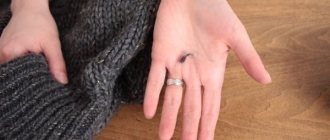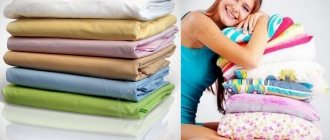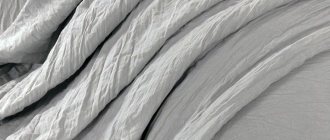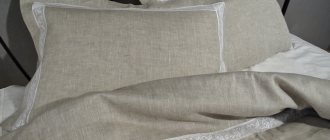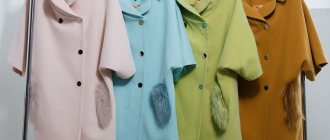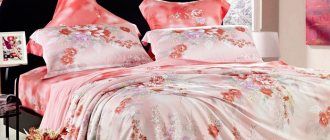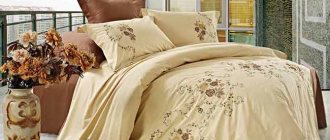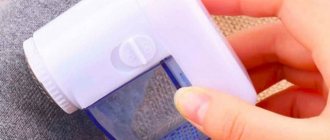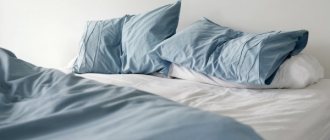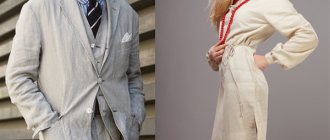A new item looks perfect, but after washing everything can change. Rolled fibers will appear on the fabric, which will ruin the appearance of the product and the mood of the owner.
Pellets are not always a sign of a low-quality product; the reason may be due to improper care and use. You can fix the problem if you have patience and take the advice of experienced housewives.
We'll tell you in this article how to remove pellets from bed linen, socks, sweatshirts and other things, and the ceiling in a car.
Methods
Machine for cleaning products from pellets
Online stores offer a wide selection of machines for eliminating lumps that have appeared. The cost of the devices is affordable, it is no more expensive than a regular clothes brush. Pros: battery operated; The charge is enough to clean several things; compactness of the machine. There are a number of large machines that operate on mains or battery power.
Well-known models from different manufacturers:
- Bomann MC 701 CB (3240)
- Polaris PLR 2022
- Smile MC 3102
- Clatronic MC 3240
Standard equipment of the device: grille with a protective cover; device body equipped with a blade; container for collecting cut lint.
The machine (depending on the model and manufacturer) most often has one or several operating modes (for example, separate adjustment of the nozzle for delicate materials).
Important! Saw clippers are not suitable for fabrics with fluff and high pile. The lint gets wrapped around the screw of the device, making it difficult to operate. And material with large loops clings to the blades, especially if a person works carelessly with the device or presses too hard on the machine.
Pros: efficient, fast and high-quality cutting of pellets and subsequent assembly into a special compartment.
Disadvantages : the procedure for removing pellets when the batteries (battery) are dead becomes slower; Not recommended for high pile materials.
Ways to get rid of pellets
You can use a machine to remove pills from clothes; there are also other methods. Some methods are not suitable for all types of fabrics.
Special device
The cutting device carefully removes them from the material. Suitable for knitted and woolen fabrics. Often used for mohair and angora - the most delicate types of wool.
The machine allows you to adjust the distance of the knife so as not to spoil the decorative elements of the product. This is the fastest, safest way to remove pellets. The device is inexpensive - 300-400 rubles.
Important
If the device version does not allow for adjusting the length of the knives, it cannot be used on long-pile fabrics.
Razor
This quick method is not suitable for delicate, fleecy, thin materials. A razor is used to remove pellets from woolen items without relief. You need to stretch and fix the thing on a horizontal, flat surface. The razor is drawn from top to bottom, then from right to left, or vice versa.
For socks, mittens, tights, this method is suitable: put on the item, shave off the pills on yourself. The razor is not suitable if the fabric is expensive or delicate. If there are puffs, the blade forms a hole in this place.
You can use a blade that is inserted into the razor. It is taken separately and carefully passed along the fibers.
We recommend
A disposable machine without a soap strip is ideal. It is sharp enough and will not damage your clothes with this strip.
Toothbrush
You will need a brush with soft bristles. Act along the fibers, scratching until the pellets go away. In this way they are removed from angora, mohair, and cashmere sweaters. To give it its former fluffiness, rinse the item in a solution of vinegar and water. Dry flat, away from the sun and heating elements.
Nail scissors
A long, monotonous method for diligent people. Each pellet is cut separately. Suitable for getting rid of pellets from pants or other small surfaces. If you handle scissors carelessly, the item can be hopelessly damaged.
To simplify the work, first comb the product with a comb with small teeth. To restore the hairiness of the material, after cutting, the clothes are treated with a soft suede brush.
Sticky roller, tape
These devices can remove pills from a T-shirt or a dress - from any thing. Suitable for recent, soft, small pellets. Scotch tape acts like wax strips:
- attach a piece to the problematic surface;
- mash a little;
- pull sharply.
It’s easier to work with a roller: you simply roll it over the surface of your trousers or jacket. To make such a video with your own hands, just fix the tape on a plastic bottle. Large old large pellets cannot be removed using this method.
Sandpaper, crackers
How to get rid of pellets: rub the problem area with sandpaper. Only fine-grain paper can be used.
Instead of sandpaper, a simple cracker will do. You need to cut a thicker piece of bread and dry it in the oven (or in the sun) on a clean baking sheet without oil. They rub the desired area like sandpaper.
Important
These improvised means are used to remove pellets on smooth, lint-free materials, otherwise the clothes will be ruined forever.
In addition to sandpaper or crackers, they use pumice. It is less rough and suitable for delicate fabrics.
Rough sponge, dish sponge
You will need the back of a dish sponge or a stiff washcloth. Wipe the product along the fibers of the fabric so as not to spoil the item. Suitable for use at home if there are few pellets, they are soft and small. It is recommended to use a new dry washcloth.
Dry cleaning
An ideal option when you have money but no time. Professionals will do all the work quickly, without problems. In addition to getting rid of pellets, the product will be treated with a prophylactic agent. This includes outerwear, expensive woolen items: angora, mohair, cashmere, alpaca.
It is better not to try to remove pills from a cashmere coat or angora blouse yourself. You shouldn’t run to the dry cleaner with a sheet or T-shirt, but you don’t mind spending money on cleaning an expensive item.
other methods
How to get rid of pellets:
- A comb with small, densely spaced teeth. They comb the item with large pellets, most of them remain on the comb.
- Use adhesive tape if you don't have tape. The patch should be very sticky. Electrical tape will do.
- Wash the item by hand with shampoo and use hair conditioner when rinsing. After a few washes the pilling will go away.
These methods will help if you pay attention to the appearance of pellets in time.
Blade or razor as an effective method
A razor can easily handle “coughed” areas, but a sharp blade can damage fabric (especially delicate ones) by cutting through or snagging the delicate material. And when using a dull blade, the pellets are almost impossible to cut off, but it is easy to leave marks and abrasions from the touch of the machine on the material. Recommended for removing pellets from bedding made from a mixture of synthetics and chintz.
Pros: high efficiency, quick results.
Disadvantages: it is easy to spoil the item; the pile has to be collected after cutting.
Scotch tape (roller with adhesive tape)
Adhesive tape or tape can handle small and loose pellets. To make it work, you should take wide tape. A cut strip of the required length is molded onto the fabric, slightly crumpled and abruptly torn off. The principle of operation of an adhesive tape roller is the same as that of adhesive tape, but it is much more convenient to use - you just need to move the roller over the surface to be treated until it is completely clean. You can also make such a video yourself by wrapping double-sided tape around a bottle.
The same method is convenient for collecting small threads and specks from black fabric.
Method for removing pellets using sandpaper and pumice
Treatment with pumice or sandpaper is based on rubbing the threads that hold the lumps. It’s enough just to stretch the fabric, walk over it with one of the products and just brush off the pellets, they will easily come off.
Important! It should be taken into account that the thinner and more delicate the material, the finer the abrasive is taken. For dense, hard products, sandpaper is recommended, and for knitwear, pumice.
Pros: quick results
Cons: Not recommended for delicate materials.
How to avoid pili
To make clothes and other products last longer and not become covered with pills, use simple tips:
- reduce to a minimum the contact of tissues prone to the appearance of saws with surfaces that can touch them;
- wash items strictly according to the instructions, using detergents for manual or delicate machine processing;
- When rinsing the product, add a special conditioner;
- Don't wring things out when it comes to spinning to keep the pile soft and smooth.
Video: washing with foil to prevent pilling
Scotch tape, adhesive roller
Treatment with adhesive tape from the side resembles waxing: we stick the strip with the adhesive side, smooth it and sharply tear it off. It is better to apply where the pili are just beginning to form.
Pros: does not damage the fabric.
Disadvantages: the method does not always cope with lumps; effectiveness depends on the stickiness of the tape.
Another method is a sticky roller for cleaning clothes. Its surface is more sticky than tape.
Pros: copes well with “rolled” areas.
Cons: not recommended for processing thin and delicate materials, high pile.
Video: How to remove lint and lumps with tape?
Nail scissors
Cutting off each lump is a very labor-intensive process. This method is usually used to combat pellets in the following cases:
- pili concentrated on small areas or projections;
- They are large in size, which is why removal requires precision.
This method can be considered auxiliary, complementing the main procedure for cleaning the product from lumps. When removing pellets with nail scissors, you must be extremely careful, trying not to touch the fabric.
Large pellets and long pile are best removed with nail scissors.
Reasons why pills form on bed linen
There are several reasons for the formation of saws on bed linen, depending on the manufacturer: the presence of synthetic fiber in the fabric, a violation of the manufacturing process (weak twist of the thread, exceeding the drawing norm, decreased fabric density).
Important! The consumer is advised to choose natural fabrics, follow product care recommendations, and buy underwear from trusted manufacturers.
But not everything depends on the company manufacturing the material. Mistakes in caring for things made by the owner also lead to their destruction. This is washing satin, cotton in too hot water; refusal of air conditioner, which helps maintain the elasticity of the product; ironing dry bed linen. In addition, too frequent washing and mechanical friction against a person during restless sleep also leads to the material rolling up.
Mold Removal
There are many ways to effectively solve this problem. The most effective of them are the following:
- Treat the contaminated surface of the mattress with a vinegar solution (9%) and leave for 1 hour. Afterwards, thoroughly clean the fabric with a stiff brush, dry and ventilate the product.
- Spread dry baking soda evenly over the mold. After 4 hours, remove the powder with a vacuum cleaner.
- Dissolve 1 tsp in 1 liter of warm water. soda and apply to the surface of the mattress using a spray bottle. After 2 hours, rinse and dry thoroughly.
- Grind the chalk to a powder and sprinkle it over the mold stains. Cover the problem area with white paper and iron it with a hot iron. Clean the surface of the product with a vacuum cleaner.
- Mix ammonia with water in a 1:1 ratio. Apply to areas affected by mold and rub with a sponge until the dark spots completely disappear. Dry and ventilate the mattress well.
Treating with chlorine bleach will also help eliminate mold from the surface of the mattress.
On what bedding materials do pills appear?
Lumps appear on fabrics that contain synthetics. The base material is wound onto such a thread, and during use the fabric simply fluffs up and pellets appear. More susceptible to rolling: woolen products, acrylic, knitwear, polyamide, fleece, polyester.
Attention! How to recognize fabric that is likely to have pilling? The labeling indicates a high content of synthetic fibers, the material is loose, the threads are long, and the pile is high. Natural materials (cotton, silk, linen) are less likely to cough.
Reasons for appearance
More often, pellets appear on soft, loose fabrics with pile or admixtures of polyester, acrylic or nylon fibers. They are located in places of constant friction or interaction with foreign objects. For example, a bag or a backpack.
The reasons may be:
Incorrect care . The washing program, temperature and detergent do not match the type of fabric.- Mixed composition of the material . Susceptible to rolling in tandem synthetic and natural fibers.
- Density and structure of fabric . Threads of medium and weak twist, weak weaving, as a result - a loose fabric that quickly loses its appearance.
Before blaming the manufacturer, carefully study the composition and recommendations on the product label. It will help you find the cause of the problem.
Following the rules of delicate laundry washing as a way to prevent lumps
Why does delicate washing reduce the likelihood of pilling? The mode is based on reducing the spin force of the laundry, and washing occurs with an increase in the volume of water in the drum, which reduces friction of the material. Delicate washing takes place at a temperature of 40 degrees , which reduces the likelihood of fabric shedding. There is no drying option in the washing machine.
Some models do not have the name “delicate wash”, it is replaced by the synonym “hand wash” .
What materials are washed this way? Washing in “delicate conditions” is ideal for artificial fabrics (polyester, elastane, viscose) and natural ones (silk, wool).
Important! Before washing, you should carefully study the label of the bed linen, which states the composition, washing and ironing mode.
For this mode, choose liquid detergents , which are easier to wash out of the fabric.
How to prevent the formation of pellets?
There are several recommendations that will help increase the service life of your laundry.
- Properly sort your laundry before washing, wash your laundry set without mixing it with other types of fabrics;
- When washing, try to avoid high temperatures as this will destroy the threads;
- Try not to use bleaches: they weaken the threads and cause color loss. In order to get rid of stubborn stains, you can use 1/4 cup of lemon juice during washing;
- If you use a dryer, dry fabrics on low or medium;
- Dry laundry is best stored in a cool, dry place, away from direct sunlight;
- It is best to have at least three sets of linen that can be changed once a week;
- To reduce contact with other fabrics, especially wool, it is recommended to fold a set of linen in a pillowcase;
If you are using laundry detergent, dissolve it in water before adding it to the machine. Whole powder can also harm the fabric.
How to remove upholstered furniture
The most common places for pilling to form on the upholstery of upholstered furniture are fabric armrests or the back of sofas and armchairs. Since in the case of furniture the surface to be treated is larger than that of clothing, you should use a machine to clean the product. Shaving or tape won't help here, but it will take a lot of time.
A special machine can deal with pellets on furniture upholstery.

